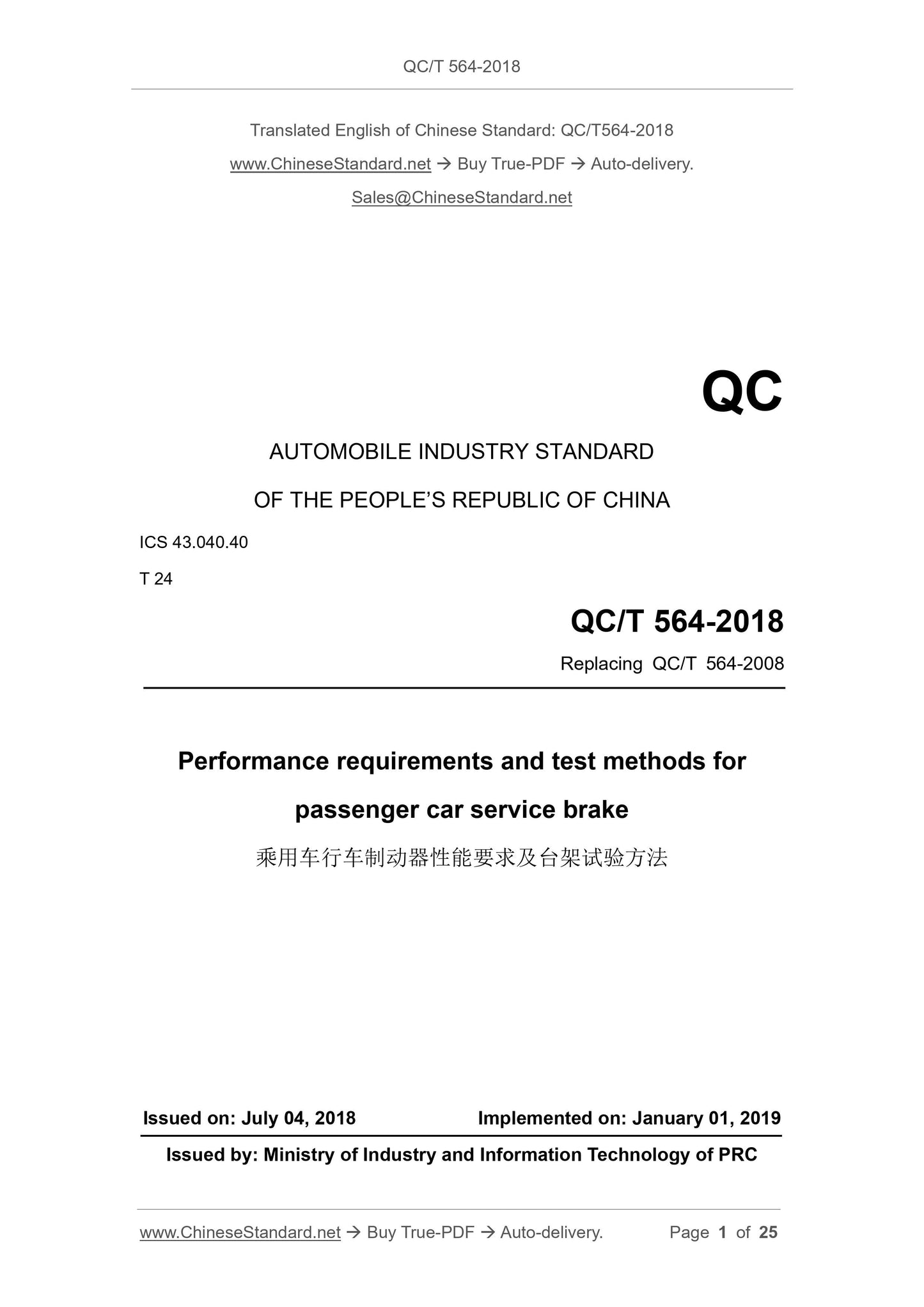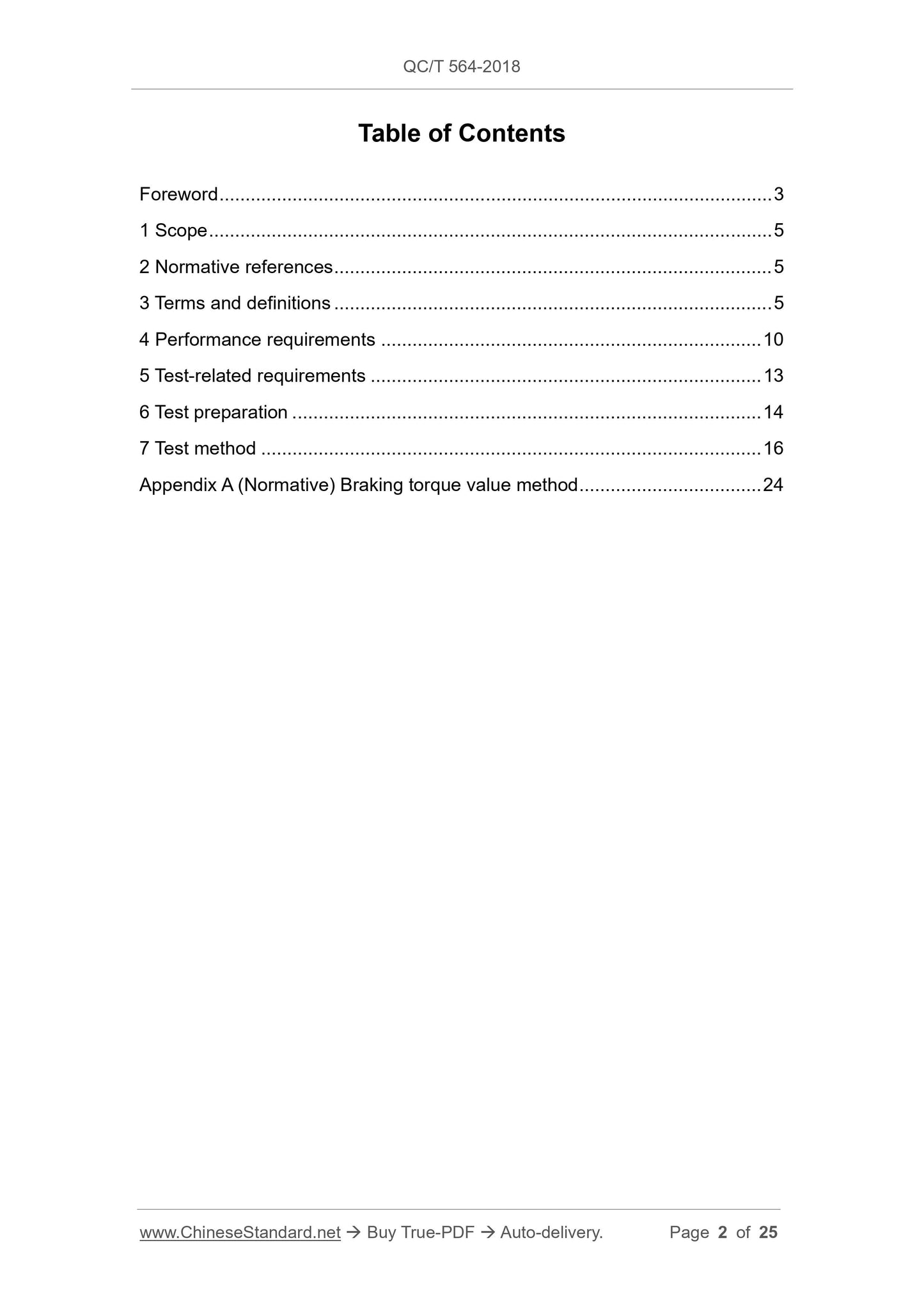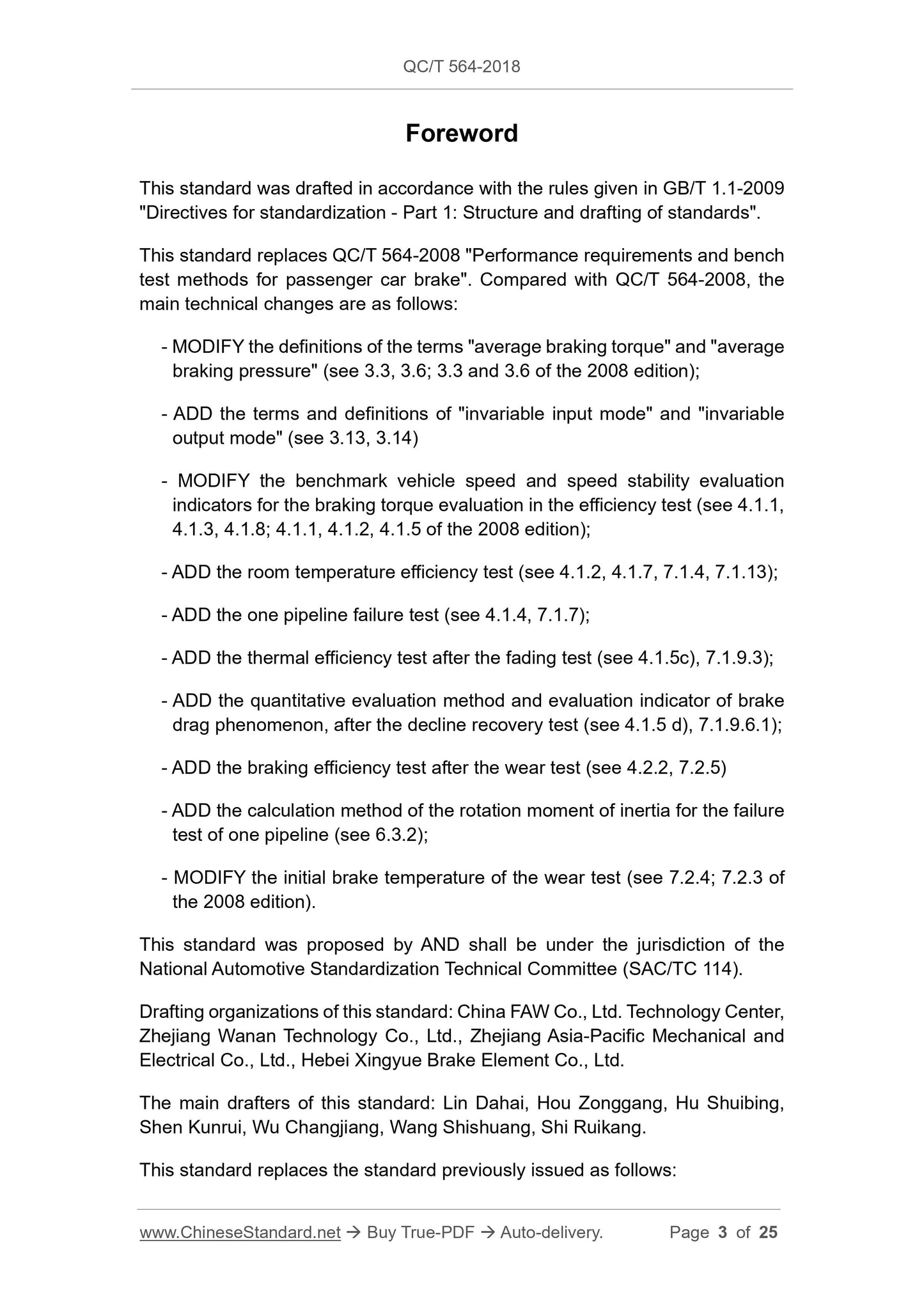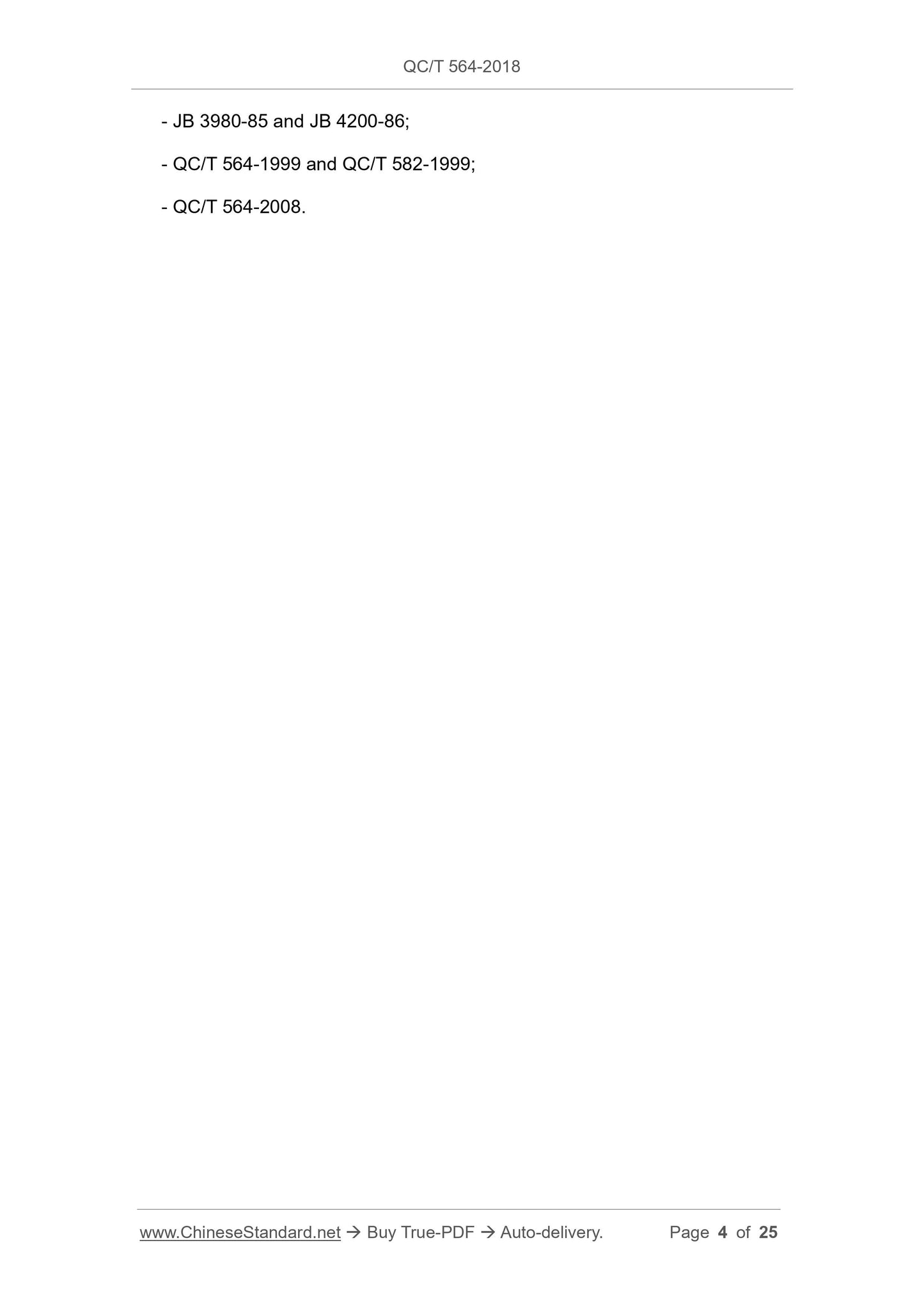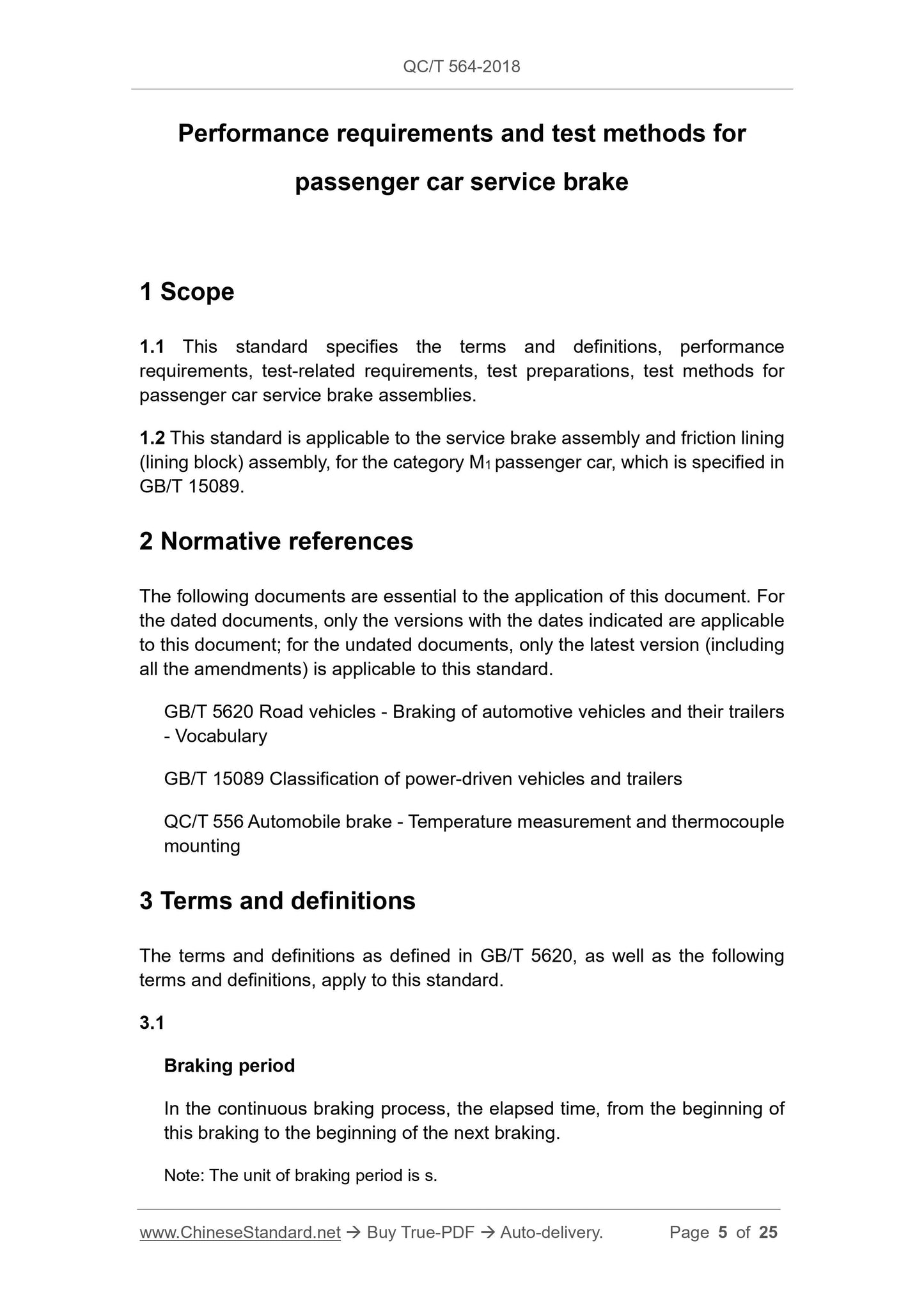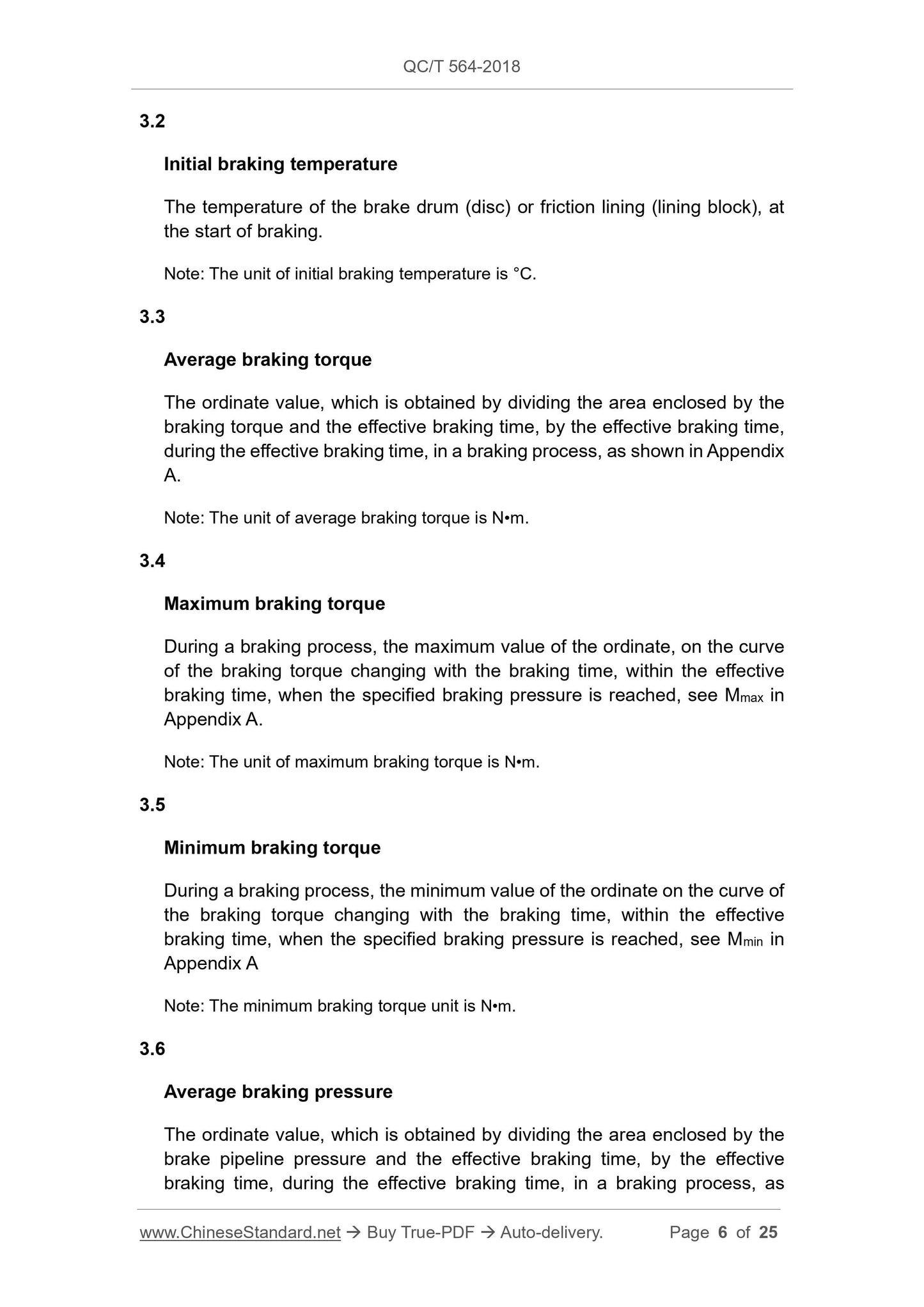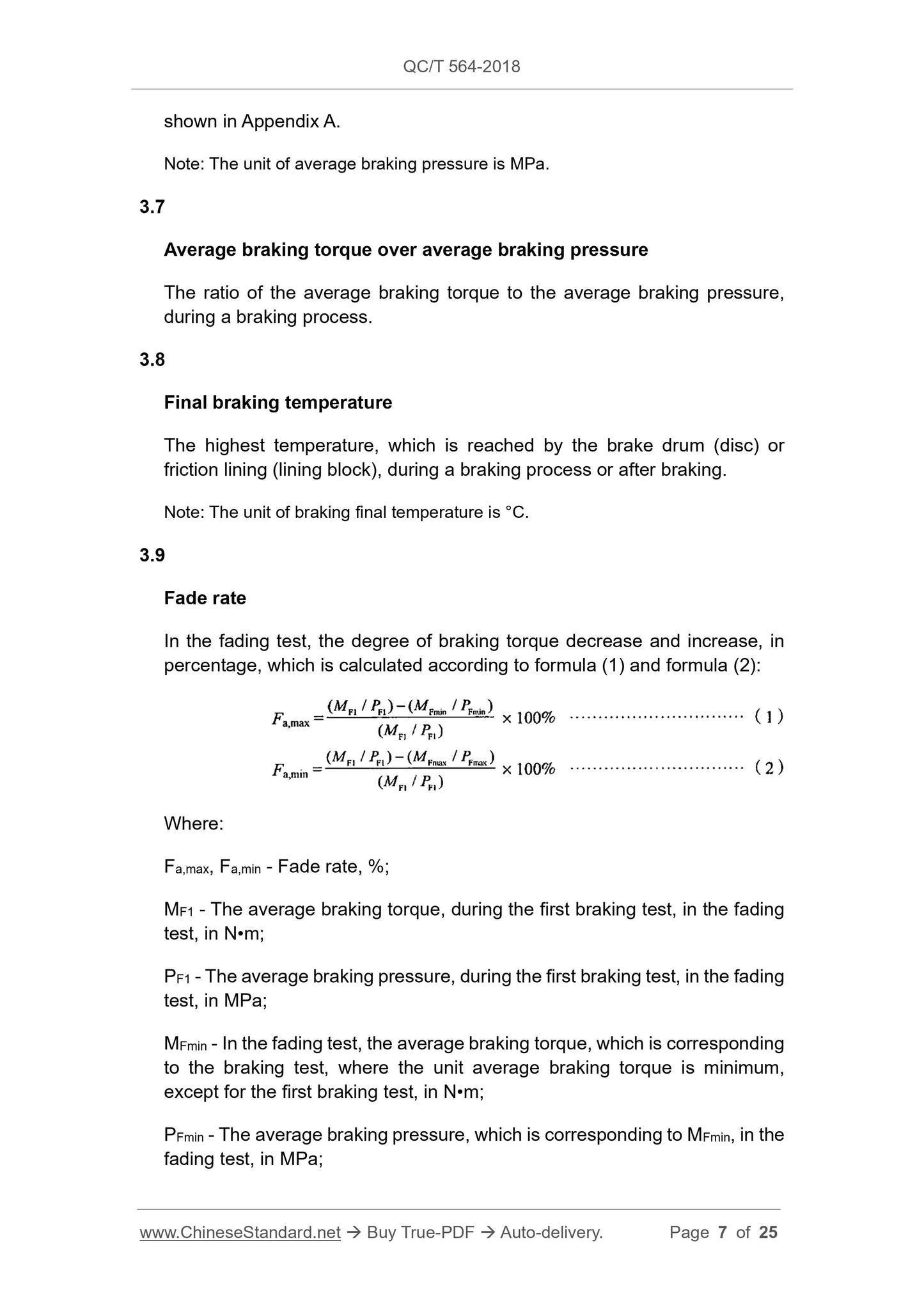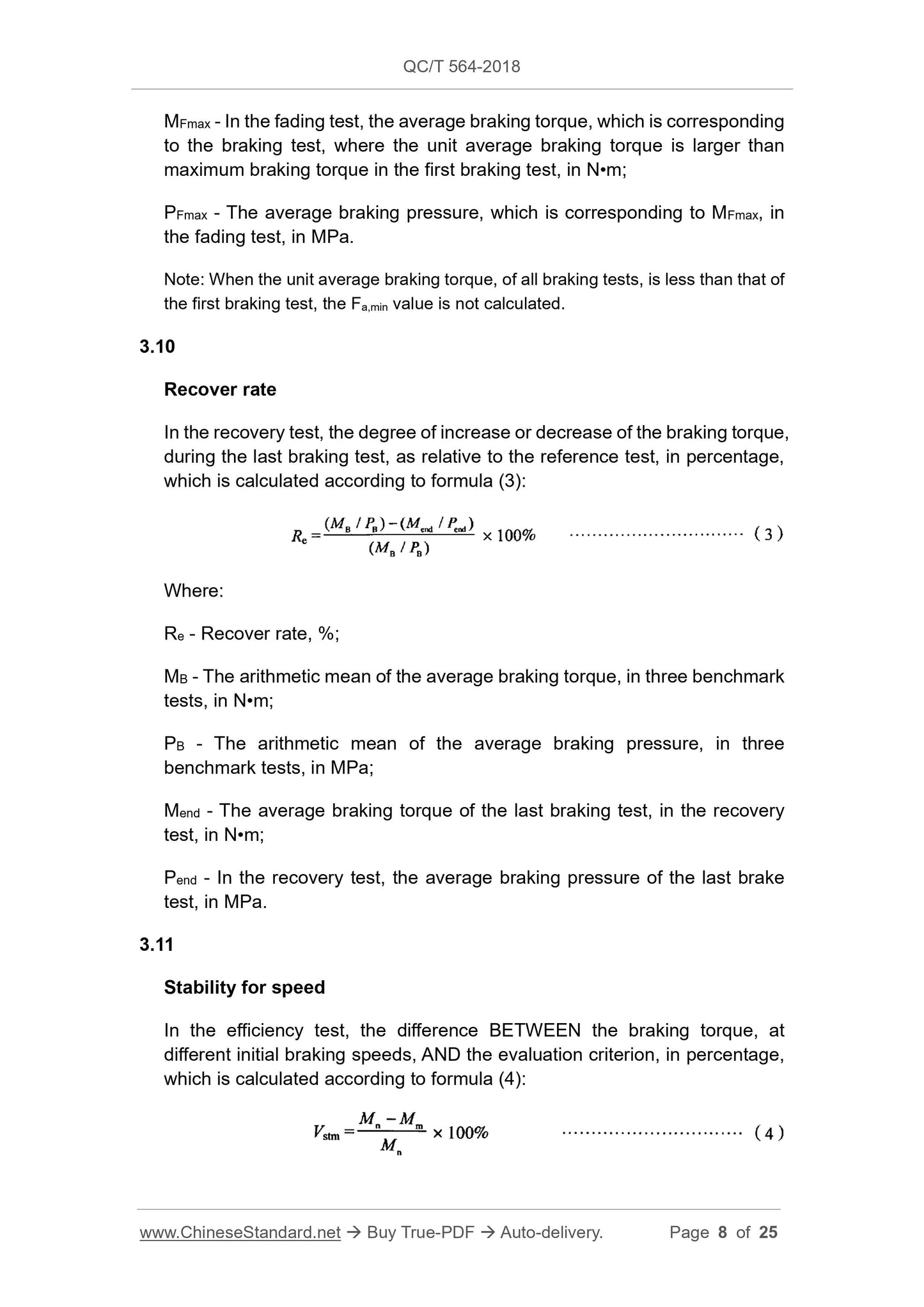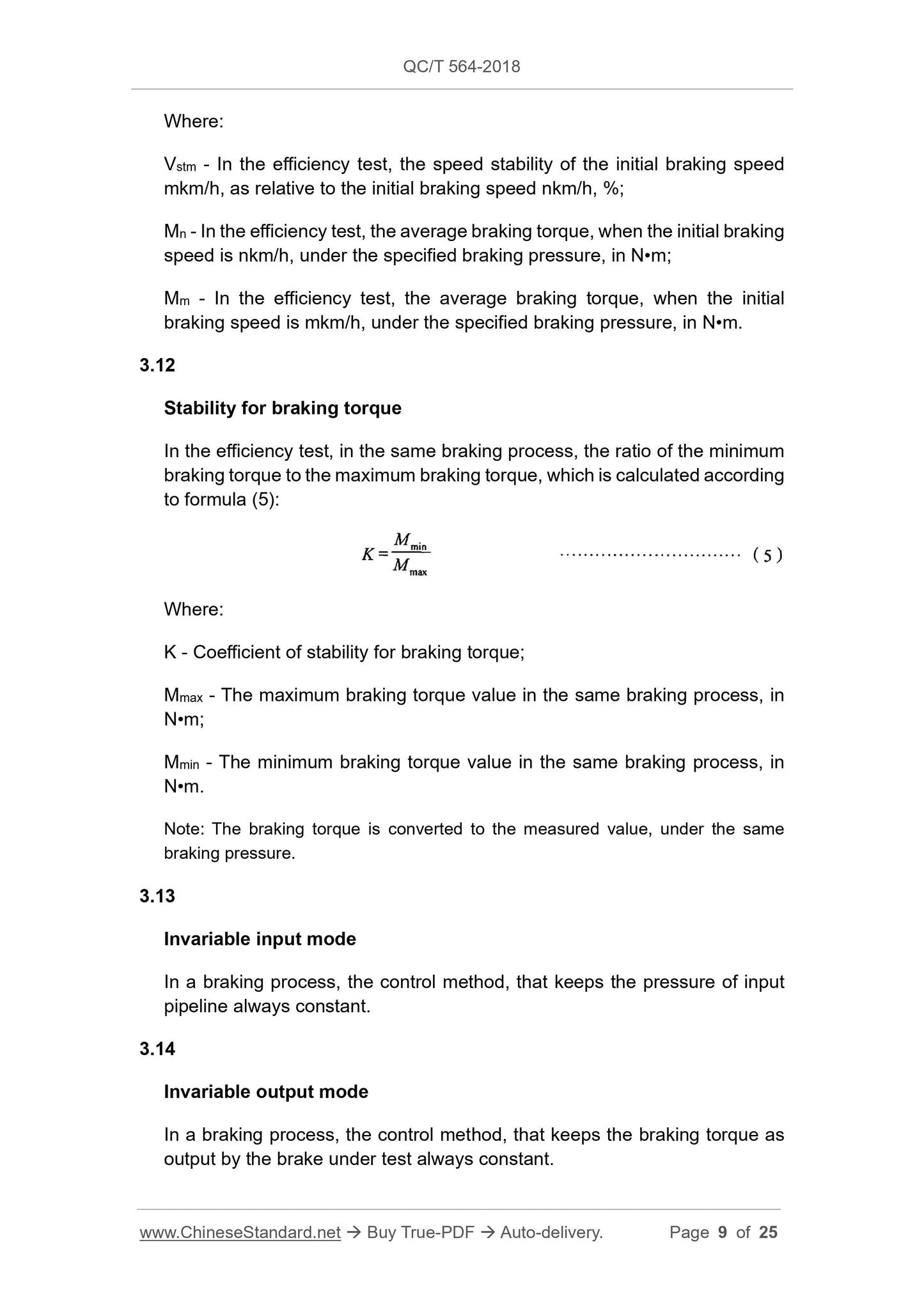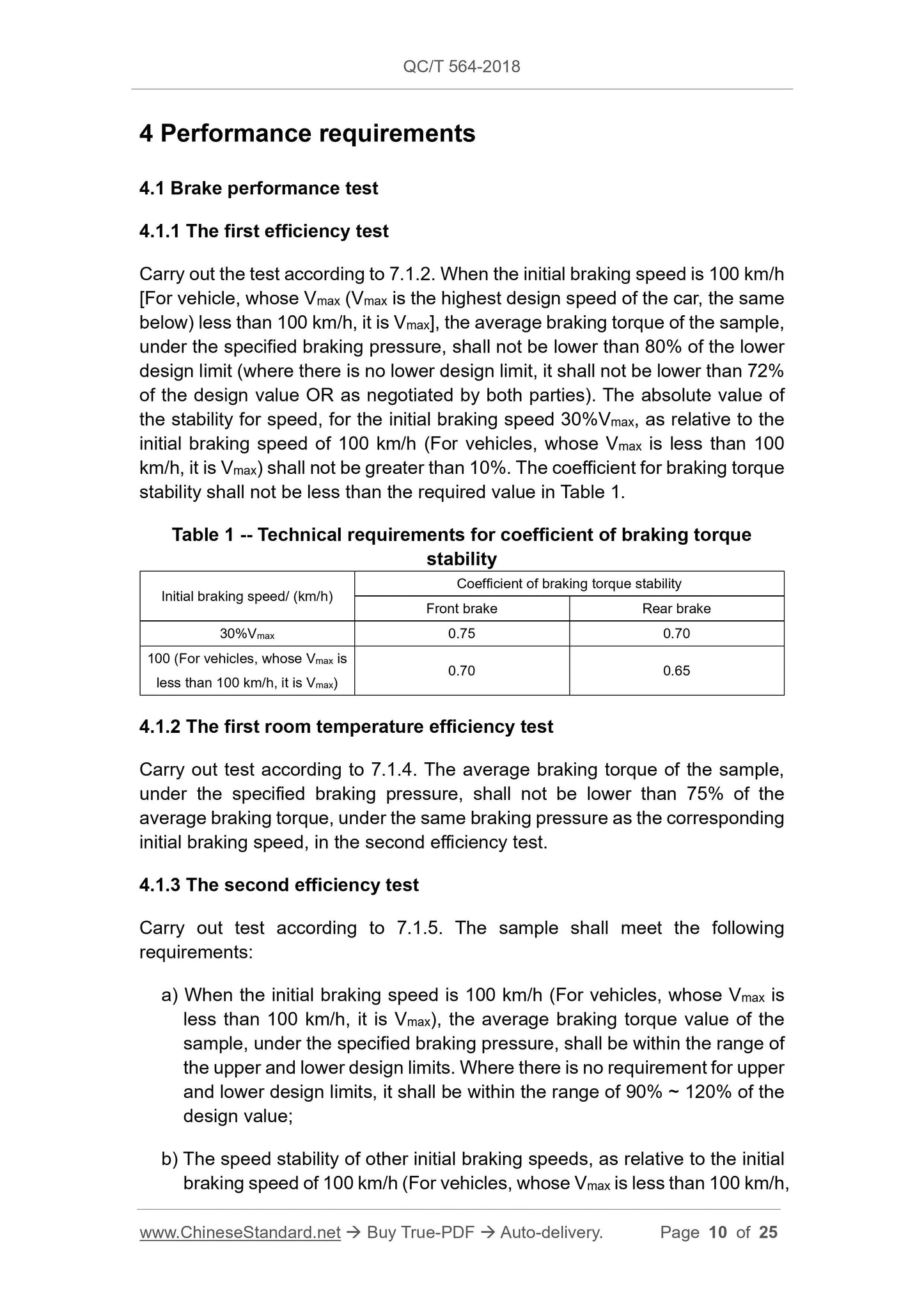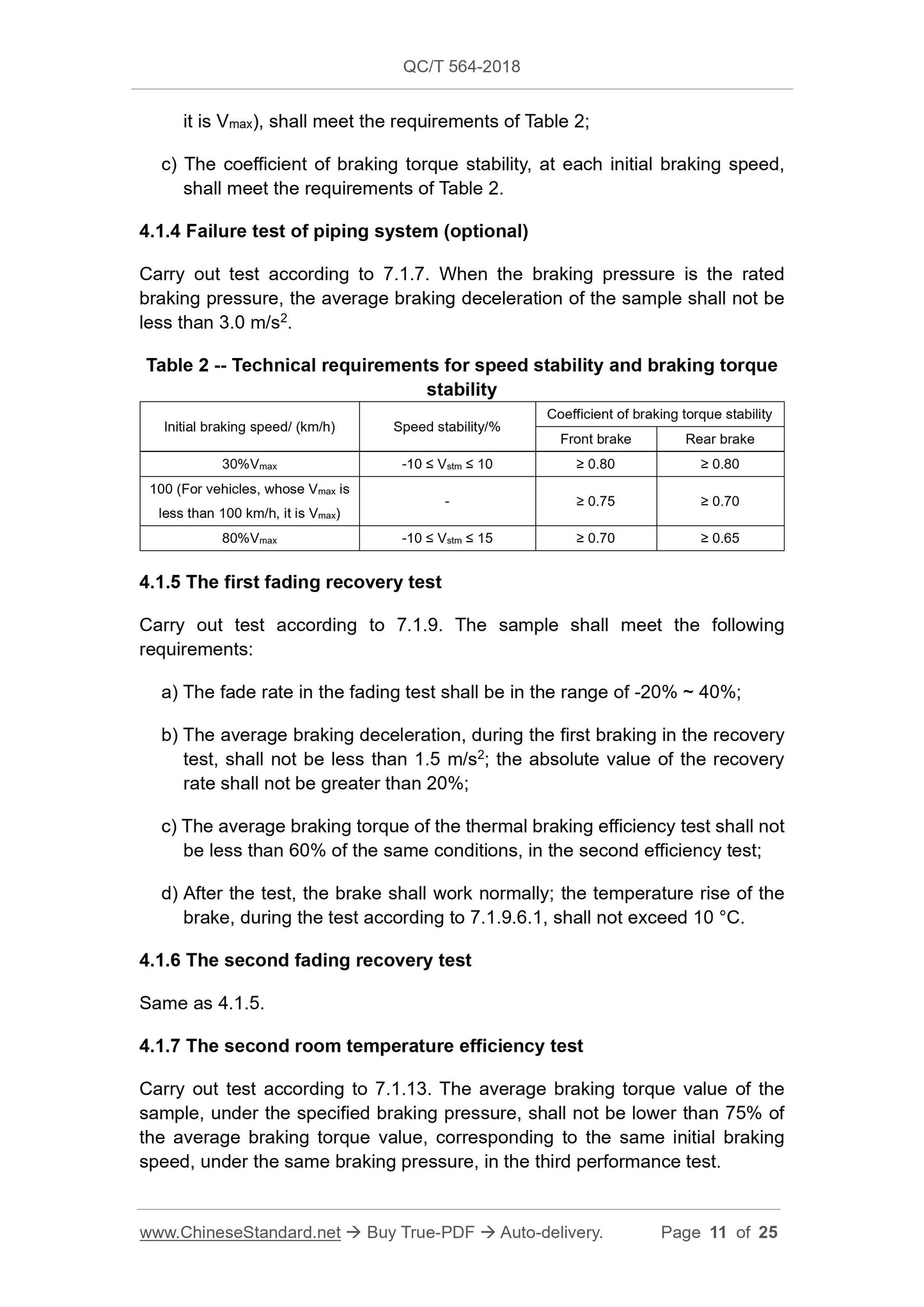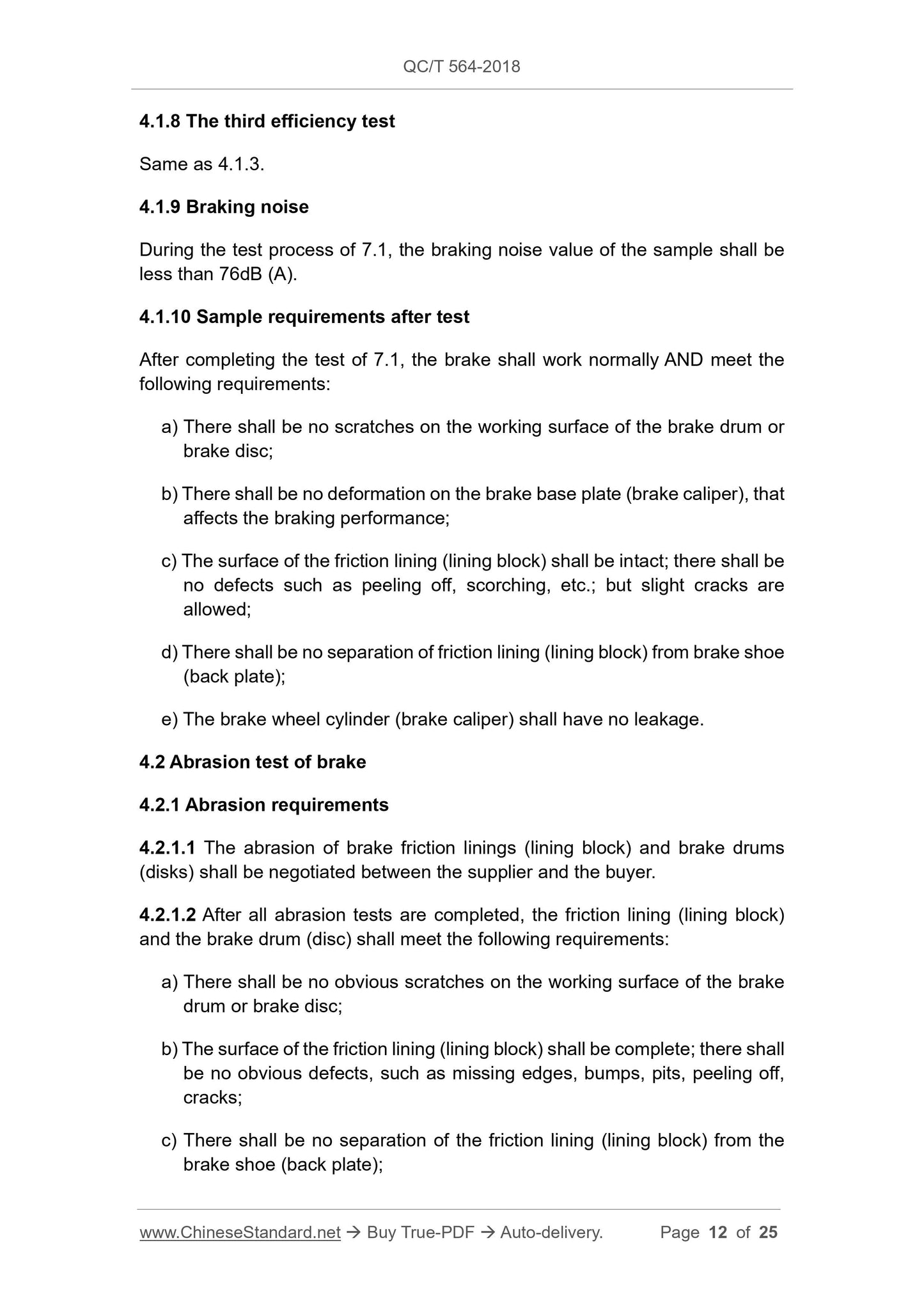1
/
su
12
PayPal, credit cards. Download editable-PDF & invoice in 1 second!
QC/T 564-2018 English PDF (QCT564-2018)
QC/T 564-2018 English PDF (QCT564-2018)
Prezzo di listino
$285.00 USD
Prezzo di listino
Prezzo scontato
$285.00 USD
Prezzo unitario
/
per
Spese di spedizione calcolate al check-out.
Impossibile caricare la disponibilità di ritiro
Delivery: 3 seconds. Download true-PDF + Invoice.
Get QUOTATION in 1-minute: Click QC/T 564-2018
Historical versions: QC/T 564-2018
Preview True-PDF (Reload/Scroll if blank)
QC/T 564-2018: Performance requirements and test methods for passenger car service brake
QC/T 564-2018
QC
AUTOMOBILE INDUSTRY STANDARD
OF THE PEOPLE’S REPUBLIC OF CHINA
ICS 43.040.40
T 24
Replacing QC/T 564-2008
Performance requirements and test methods for
passenger car service brake
ISSUED ON: JULY 04, 2018
IMPLEMENTED ON: JANUARY 01, 2019
Issued by: Ministry of Industry and Information Technology of PRC
Table of Contents
Foreword ... 3
1 Scope ... 5
2 Normative references ... 5
3 Terms and definitions ... 5
4 Performance requirements ... 10
5 Test-related requirements ... 13
6 Test preparation ... 14
7 Test method ... 16
Appendix A (Normative) Braking torque value method ... 24
Performance requirements and test methods for
passenger car service brake
1 Scope
1.1 This standard specifies the terms and definitions, performance
requirements, test-related requirements, test preparations, test methods for
passenger car service brake assemblies.
1.2 This standard is applicable to the service brake assembly and friction lining
(lining block) assembly, for the category M1 passenger car, which is specified in
GB/T 15089.
2 Normative references
The following documents are essential to the application of this document. For
the dated documents, only the versions with the dates indicated are applicable
to this document; for the undated documents, only the latest version (including
all the amendments) is applicable to this standard.
GB/T 5620 Road vehicles - Braking of automotive vehicles and their trailers
- Vocabulary
GB/T 15089 Classification of power-driven vehicles and trailers
QC/T 556 Automobile brake - Temperature measurement and thermocouple
mounting
3 Terms and definitions
The terms and definitions as defined in GB/T 5620, as well as the following
terms and definitions, apply to this standard.
3.1
Braking period
In the continuous braking process, the elapsed time, from the beginning of
this braking to the beginning of the next braking.
Note: The unit of braking period is s.
4.1.8 The third efficiency test
Same as 4.1.3.
4.1.9 Braking noise
During the test process of 7.1, the braking noise value of the sample shall be
less than 76dB (A).
4.1.10 Sample requirements after test
After completing the test of 7.1, the brake shall work normally AND meet the
following requirements:
a) There shall be no scratches on the working surface of the brake drum or
brake disc;
b) There shall be no deformation on the brake base plate (brake caliper), that
affects the braking performance;
c) The surface of the friction lining (lining block) shall be intact; there shall be
no defects such as peeling off, scorching, etc.; but slight cracks are
allowed;
d) There shall be no separation of friction lining (lining block) from brake shoe
(back plate);
e) The brake wheel cylinder (brake caliper) shall have no leakage.
4.2 Abrasion test of brake
4.2.1 Abrasion requirements
4.2.1.1 The abrasion of brake friction linings (lining block) and brake drums
(disks) shall be negotiated between the supplier and the buyer.
4.2.1.2 After all abrasion tests are completed, the friction lining (lining block)
and the brake drum (disc) shall meet the following requirements:
a) There shall be no obvious scratches on the working surface of the brake
drum or brake disc;
b) The surface of the friction lining (lining block) shall be complete; there shall
be no obvious defects, such as missing edges, bumps, pits, peeling off,
cracks;
c) There shall be no separation of the friction lining (lining block) from the
brake shoe (back plate);
d) The surface of the friction lining (lining block) shall not have cracks, which
penetrate through the entire friction surface.
4.2.2 Inspection of braking performance
Compared with before the abrasion test, the change of average braking torque,
under the specified braking pressure, shall not exceed ±15%.
5 Test-related requirements
5.1 Test equipment
5.1.1 The test equipment is an inertial brake test bench (both single and double
wheels are acceptable). Its performance indicators shall meet the test
requirements of this standard.
5.1.2 The brake line pressure supply system of the test equipment shall meet
the requirements of various brake working conditions, for the brake line
pressure, AND be stable. The rate of pressure rise and fall of the brake line
shall be controlled within the range of (25 ± 5) MPa/s.
5.1.3 The brake cooling device of the test equipment shall make the wind speed
at the brake under test reach 11 m/s, AND cover the entire brake assembly.
5.1.4 The control error of brake pipeline pressure, braking torque, test bench's
spindle speed shall not exceed ±3%. The relative error of the rotation moment
of inertia (including the inertia of the rotating part of the test bench) shall not
exceed ±5%.
5.1.5 The test equipment shall be able to continuously record the following
parameters. The measurement error shall meet the following requirements:
a) The braking output torque is ±1.0%;
b) The braking pressure is ±1.0%;
c) The spindle speed of the test bench is ±1.0%;
d) The braking time is ±0.01 s;
e) The temperature of the brake drum (disc) and brake lining (lining block) is
±3 °C, when the temperature is not higher than 300 °C; it is ±1.0%, when
the temperature is higher than 300 °C.
5.1.6 The device and thermocouple, which are used for measuring the
temperature of the brake drum (disc) and friction lining (lining block), shall
comply with the relevant requirements in QC/T 556.
5.1.7 The accuracy grade of the instrument or meter, which indicates each
parameter, shall not be lower than grade 2.5.
5.2 Other requirements
5.2.1 All test vehicle speeds shall be rounded off to an integral multiple of 5.
5.2.2 Except for the fading test AND unless otherwise specified, during the test,
the cooling wind speed is 11 m/s; the temperature of the cooling air is room
temperature.
5.2.3 Unless otherwise specified, the vehicle speed, at the end of all braking
tests, shall be less than 5 km/h
5.2.4 When measuring braking noise, the pickup head of the sound level meter
shall be placed in the rotating plane of the brake to be tested, 500 mm right
above the axis of rotation of the brake; the pickup head shall be equipped with
a wind protection ball.
5.2.5 For all tests, which are carried out according to the brake deceleration
control, it shall use the formula (12) to convert the brake deceleration into the
braking torque control value of the test bench.
5.2.6 The radial runout of the brake drum, after installation (measured at the
middle of the width direction of the friction surface of the brake drum), shall not
be greater than 0.2 mm. The axial runout of the friction surface of the brake disc,
after installation (measured at the effective radius of the brake disc), shall not
be greater than 0.15 mm.
6 Test preparation
6.1 Thermocouple installation
Install the thermocouple, according to the relevant requirements in QC/T 556.
6.2 Determination of the spindle speed of test bench
The spindle speed of the test bench is determined according to formula (6):
Where:
n - Spindle speed of the test bench, r/min;
V - Test vehicle speed, km /h;
7.1.2.3 Take no less than 5 points for the test, within the specified braking
pressure range. The interval between the test points shall be as equal as
possible. The maximum increase in braking pressure shall not be higher tha...
Get QUOTATION in 1-minute: Click QC/T 564-2018
Historical versions: QC/T 564-2018
Preview True-PDF (Reload/Scroll if blank)
QC/T 564-2018: Performance requirements and test methods for passenger car service brake
QC/T 564-2018
QC
AUTOMOBILE INDUSTRY STANDARD
OF THE PEOPLE’S REPUBLIC OF CHINA
ICS 43.040.40
T 24
Replacing QC/T 564-2008
Performance requirements and test methods for
passenger car service brake
ISSUED ON: JULY 04, 2018
IMPLEMENTED ON: JANUARY 01, 2019
Issued by: Ministry of Industry and Information Technology of PRC
Table of Contents
Foreword ... 3
1 Scope ... 5
2 Normative references ... 5
3 Terms and definitions ... 5
4 Performance requirements ... 10
5 Test-related requirements ... 13
6 Test preparation ... 14
7 Test method ... 16
Appendix A (Normative) Braking torque value method ... 24
Performance requirements and test methods for
passenger car service brake
1 Scope
1.1 This standard specifies the terms and definitions, performance
requirements, test-related requirements, test preparations, test methods for
passenger car service brake assemblies.
1.2 This standard is applicable to the service brake assembly and friction lining
(lining block) assembly, for the category M1 passenger car, which is specified in
GB/T 15089.
2 Normative references
The following documents are essential to the application of this document. For
the dated documents, only the versions with the dates indicated are applicable
to this document; for the undated documents, only the latest version (including
all the amendments) is applicable to this standard.
GB/T 5620 Road vehicles - Braking of automotive vehicles and their trailers
- Vocabulary
GB/T 15089 Classification of power-driven vehicles and trailers
QC/T 556 Automobile brake - Temperature measurement and thermocouple
mounting
3 Terms and definitions
The terms and definitions as defined in GB/T 5620, as well as the following
terms and definitions, apply to this standard.
3.1
Braking period
In the continuous braking process, the elapsed time, from the beginning of
this braking to the beginning of the next braking.
Note: The unit of braking period is s.
4.1.8 The third efficiency test
Same as 4.1.3.
4.1.9 Braking noise
During the test process of 7.1, the braking noise value of the sample shall be
less than 76dB (A).
4.1.10 Sample requirements after test
After completing the test of 7.1, the brake shall work normally AND meet the
following requirements:
a) There shall be no scratches on the working surface of the brake drum or
brake disc;
b) There shall be no deformation on the brake base plate (brake caliper), that
affects the braking performance;
c) The surface of the friction lining (lining block) shall be intact; there shall be
no defects such as peeling off, scorching, etc.; but slight cracks are
allowed;
d) There shall be no separation of friction lining (lining block) from brake shoe
(back plate);
e) The brake wheel cylinder (brake caliper) shall have no leakage.
4.2 Abrasion test of brake
4.2.1 Abrasion requirements
4.2.1.1 The abrasion of brake friction linings (lining block) and brake drums
(disks) shall be negotiated between the supplier and the buyer.
4.2.1.2 After all abrasion tests are completed, the friction lining (lining block)
and the brake drum (disc) shall meet the following requirements:
a) There shall be no obvious scratches on the working surface of the brake
drum or brake disc;
b) The surface of the friction lining (lining block) shall be complete; there shall
be no obvious defects, such as missing edges, bumps, pits, peeling off,
cracks;
c) There shall be no separation of the friction lining (lining block) from the
brake shoe (back plate);
d) The surface of the friction lining (lining block) shall not have cracks, which
penetrate through the entire friction surface.
4.2.2 Inspection of braking performance
Compared with before the abrasion test, the change of average braking torque,
under the specified braking pressure, shall not exceed ±15%.
5 Test-related requirements
5.1 Test equipment
5.1.1 The test equipment is an inertial brake test bench (both single and double
wheels are acceptable). Its performance indicators shall meet the test
requirements of this standard.
5.1.2 The brake line pressure supply system of the test equipment shall meet
the requirements of various brake working conditions, for the brake line
pressure, AND be stable. The rate of pressure rise and fall of the brake line
shall be controlled within the range of (25 ± 5) MPa/s.
5.1.3 The brake cooling device of the test equipment shall make the wind speed
at the brake under test reach 11 m/s, AND cover the entire brake assembly.
5.1.4 The control error of brake pipeline pressure, braking torque, test bench's
spindle speed shall not exceed ±3%. The relative error of the rotation moment
of inertia (including the inertia of the rotating part of the test bench) shall not
exceed ±5%.
5.1.5 The test equipment shall be able to continuously record the following
parameters. The measurement error shall meet the following requirements:
a) The braking output torque is ±1.0%;
b) The braking pressure is ±1.0%;
c) The spindle speed of the test bench is ±1.0%;
d) The braking time is ±0.01 s;
e) The temperature of the brake drum (disc) and brake lining (lining block) is
±3 °C, when the temperature is not higher than 300 °C; it is ±1.0%, when
the temperature is higher than 300 °C.
5.1.6 The device and thermocouple, which are used for measuring the
temperature of the brake drum (disc) and friction lining (lining block), shall
comply with the relevant requirements in QC/T 556.
5.1.7 The accuracy grade of the instrument or meter, which indicates each
parameter, shall not be lower than grade 2.5.
5.2 Other requirements
5.2.1 All test vehicle speeds shall be rounded off to an integral multiple of 5.
5.2.2 Except for the fading test AND unless otherwise specified, during the test,
the cooling wind speed is 11 m/s; the temperature of the cooling air is room
temperature.
5.2.3 Unless otherwise specified, the vehicle speed, at the end of all braking
tests, shall be less than 5 km/h
5.2.4 When measuring braking noise, the pickup head of the sound level meter
shall be placed in the rotating plane of the brake to be tested, 500 mm right
above the axis of rotation of the brake; the pickup head shall be equipped with
a wind protection ball.
5.2.5 For all tests, which are carried out according to the brake deceleration
control, it shall use the formula (12) to convert the brake deceleration into the
braking torque control value of the test bench.
5.2.6 The radial runout of the brake drum, after installation (measured at the
middle of the width direction of the friction surface of the brake drum), shall not
be greater than 0.2 mm. The axial runout of the friction surface of the brake disc,
after installation (measured at the effective radius of the brake disc), shall not
be greater than 0.15 mm.
6 Test preparation
6.1 Thermocouple installation
Install the thermocouple, according to the relevant requirements in QC/T 556.
6.2 Determination of the spindle speed of test bench
The spindle speed of the test bench is determined according to formula (6):
Where:
n - Spindle speed of the test bench, r/min;
V - Test vehicle speed, km /h;
7.1.2.3 Take no less than 5 points for the test, within the specified braking
pressure range. The interval between the test points shall be as equal as
possible. The maximum increase in braking pressure shall not be higher tha...
Share
